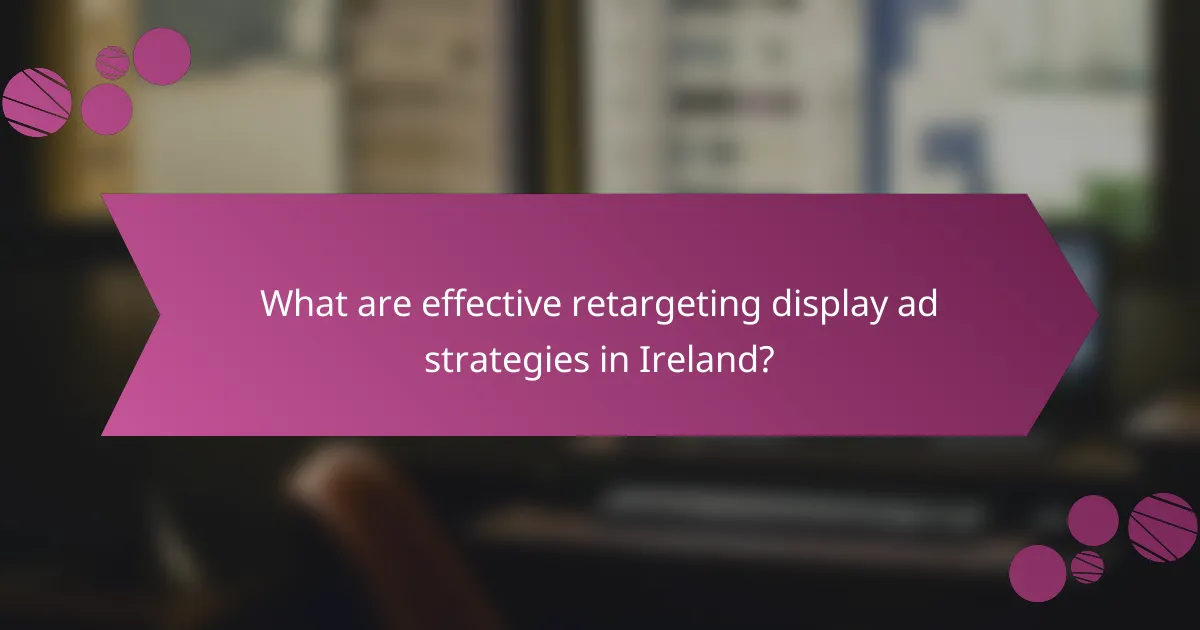Retargeting display ads are a powerful tool for enhancing customer engagement and driving conversions by delivering personalized experiences based on user interactions. By employing advanced targeting techniques and carefully managing ad frequency, brands can optimize their advertising efforts to improve recall and conversion rates. Effective measurement of conversion rates is crucial, requiring the use of analytics tools and a clear understanding of user actions that lead to desired outcomes.

What are effective retargeting display ad strategies in Ireland?
Effective retargeting display ad strategies in Ireland focus on personalized experiences, leveraging customer data, and utilizing advanced targeting techniques. These methods enhance engagement and conversion rates by delivering relevant ads to users who have previously interacted with a brand.
Personalized ad content
Personalized ad content tailors messages based on user behavior and preferences. By analyzing past interactions, brands can create ads that resonate more with individual users, increasing the likelihood of conversion. For example, if a user viewed specific products, ads showcasing those items or similar products can be more effective.
To implement personalized content, consider using dynamic text replacement and segmentation based on user demographics or interests. This approach not only improves engagement but can also lead to higher click-through rates.
Dynamic product ads
Dynamic product ads automatically display relevant products to users based on their browsing history. This strategy allows brands to showcase items users have shown interest in, making the ads more appealing and relevant. For instance, if a user adds a product to their cart but does not complete the purchase, a dynamic ad can remind them of that item.
Using a product feed, these ads can be updated in real-time, ensuring that users see the most current offerings. This method is particularly effective for e-commerce businesses looking to recover abandoned carts and boost sales.
Sequential retargeting
Sequential retargeting involves showing users a series of ads that tell a story or guide them through a purchase journey. This method helps maintain user interest and can lead to higher conversion rates by gradually introducing more information about a product or service.
For example, the first ad might highlight a product’s benefits, followed by an ad showcasing customer testimonials, and finally an ad with a limited-time discount. This structured approach can effectively nurture leads and encourage decision-making.
Cross-device targeting
Cross-device targeting ensures that users receive consistent messaging across multiple devices, such as smartphones, tablets, and desktops. This strategy acknowledges that users often switch devices during their purchasing journey, and maintaining brand visibility is crucial.
To implement cross-device targeting, utilize tracking technologies that connect user behavior across devices. This approach can significantly enhance the effectiveness of retargeting campaigns by ensuring that users receive relevant ads regardless of the device they are using.
Utilizing customer data
Utilizing customer data is essential for creating effective retargeting campaigns. By analyzing data from previous interactions, brands can identify patterns and preferences, allowing for more targeted ad placements. This data can include browsing history, purchase behavior, and engagement metrics.
However, it’s important to comply with data protection regulations, such as GDPR in Ireland, when collecting and using customer data. Ensure transparency with users about how their data will be used and provide options for opting out of tracking if desired.

How does ad frequency impact conversion rates?
Ad frequency significantly affects conversion rates by influencing how often potential customers see your ads. Striking the right balance in frequency can enhance brand recall and drive conversions, while too much or too little exposure can lead to diminishing returns.
Optimal frequency range
The optimal frequency range for display ads typically falls between three to seven impressions per user per week. This range allows for sufficient exposure to reinforce the message without overwhelming the audience. Testing different frequencies can help identify the sweet spot for your specific audience and campaign goals.
Effects of high frequency
High ad frequency can lead to ad fatigue, where users become annoyed or disengaged due to excessive exposure. This often results in increased click-through rates initially, but can ultimately decrease conversion rates as users start to ignore or block the ads. It’s crucial to monitor engagement metrics to avoid crossing this threshold.
Effects of low frequency
Low ad frequency may result in insufficient brand exposure, preventing potential customers from recognizing or recalling your brand when making purchasing decisions. If users see your ads too infrequently, they may forget about your offerings, leading to lower conversion rates. A balance must be struck to ensure your ads are memorable without being intrusive.

What are the best practices for measuring conversion rates?
Measuring conversion rates effectively involves tracking user actions that lead to desired outcomes, such as purchases or sign-ups. Key practices include utilizing analytics tools, understanding attribution models, and clearly defining conversion goals.
Using Google Analytics
Google Analytics is a powerful tool for measuring conversion rates as it provides detailed insights into user behavior on your website. By setting up goals within Google Analytics, you can track specific actions, such as form submissions or product purchases, and analyze the conversion rates associated with different traffic sources.
To get started, ensure that your Google Analytics account is properly configured to capture relevant data. Regularly review the conversion reports to identify trends and areas for improvement, such as optimizing landing pages or adjusting ad targeting.
Attribution models
Attribution models help determine how different marketing channels contribute to conversions. Common models include last-click, first-click, and linear attribution, each providing a different perspective on how to assign credit for conversions across various touchpoints.
Choosing the right attribution model is crucial as it impacts your understanding of which strategies are most effective. For instance, a last-click model may undervalue the role of earlier interactions, while a multi-touch model offers a more comprehensive view of the customer journey.
Setting conversion goals
Clearly defined conversion goals are essential for measuring success. These goals should be specific, measurable, achievable, relevant, and time-bound (SMART). Examples include increasing newsletter sign-ups by a certain percentage within a quarter or boosting sales from a specific campaign.
Regularly review and adjust your conversion goals based on performance data and market changes. This ensures that your measurement strategies remain aligned with your business objectives and can adapt to evolving customer behaviors.

What tools can enhance retargeting efforts?
Several tools can significantly improve retargeting efforts by optimizing ad placements and targeting strategies. Utilizing platforms like AdRoll, Facebook Ads Manager, and Google Ads can help marketers effectively reach their audience and boost conversion rates.
AdRoll
AdRoll is a comprehensive retargeting platform that allows businesses to create personalized ad campaigns across various channels. It offers features like dynamic ads, which automatically adjust content based on user behavior, and cross-device tracking to ensure consistent messaging.
To maximize effectiveness, consider setting up segmented audiences based on user interactions. For example, target users who visited specific product pages but did not complete a purchase. This tailored approach can lead to higher engagement and conversion rates.
Facebook Ads Manager
Facebook Ads Manager is a powerful tool for retargeting on social media, enabling businesses to reach users who have previously interacted with their brand. It provides options for creating custom audiences based on website visits, app usage, or engagement with previous ads.
Utilize the platform’s lookalike audience feature to expand your reach by targeting new users similar to your existing customers. Regularly analyze ad performance metrics to adjust your strategy and optimize ad spend effectively.
Google Ads
Google Ads offers robust retargeting capabilities through its Display Network and Search Ads. Advertisers can create remarketing lists to show ads to users who have previously visited their website or engaged with their content.
Consider using responsive display ads, which automatically adjust their size and format to fit available ad spaces, increasing visibility. Regularly review your campaigns to refine targeting and improve return on investment, aiming for a frequency that balances visibility without overwhelming potential customers.

What are the prerequisites for successful retargeting campaigns?
Successful retargeting campaigns require a clear understanding of your audience, effective tracking mechanisms, and well-defined goals. Establishing these prerequisites ensures that your ads reach the right people at the right time, maximizing conversion potential.
Understanding audience segments
Identifying audience segments is crucial for effective retargeting. This involves categorizing users based on their interactions with your website, such as pages visited, products viewed, or actions taken. Common segments include cart abandoners, previous purchasers, and users who spent significant time on specific pages.
To optimize your campaigns, tailor your messaging and offers to each segment. For instance, you might offer a discount to cart abandoners while showcasing new products to previous customers. This targeted approach can significantly enhance engagement and conversion rates.
Setting up tracking pixels
Tracking pixels are essential for monitoring user behavior and enabling retargeting. These small snippets of code are placed on your website to collect data on visitors, allowing you to create custom audiences for your ads. Ensure that your pixels are correctly installed on key pages, such as product pages and checkout pages.
Be mindful of privacy regulations, such as GDPR in Europe, which require user consent for tracking. Implement clear consent mechanisms and provide users with options to manage their preferences. Regularly test your tracking setup to ensure accurate data collection and audience segmentation.









